Information for this page comes from the following sources: Masako Schwalbenitz, Irmgard Hörmann, Roy Helms, Don Johnson, and For Beer and The Bible: One Hundred Years at The Lutheran Church of Honolulu: 1900-2000 by Saundra Wagner-Wright.
Photos by Kathy Crosier and Linda Mizuno.
Significant Furnishings and Appointments in the LCH Nave
Altar
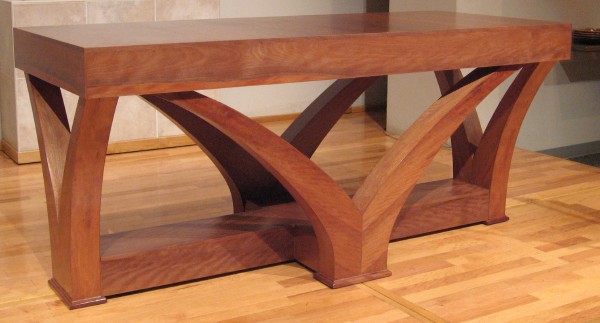
The altar was fabricated of Hawaiian ‘ohi‘a wood by Masako Schwalbenitz and donated by the Larry Nitz family. The original design was by Reese Fowler of Seattle. The altar was first used in worship on February 20, 2005 (Lent II). More details about the design, fabrication, and installation of the altar.
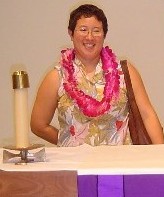 Local woodworker Masako Schwalbenitz holds an MFA in painting with a minor in woodworking from Rochester Institute of Technology, NY. She started woodworking part-time after returning to Hawai‘i in 1997, and after various woodworking-related jobs and a year and a half apprenticeship on the Big Island, she established herself as a fully self-employed woodworker (and painter) in 2002. For the last four years, she has served as chairperson for Hawai‘i’s Woodshow, an annual juried woodworking exhibition organized by the Hawai‘i Forest Industry Association.
Local woodworker Masako Schwalbenitz holds an MFA in painting with a minor in woodworking from Rochester Institute of Technology, NY. She started woodworking part-time after returning to Hawai‘i in 1997, and after various woodworking-related jobs and a year and a half apprenticeship on the Big Island, she established herself as a fully self-employed woodworker (and painter) in 2002. For the last four years, she has served as chairperson for Hawai‘i’s Woodshow, an annual juried woodworking exhibition organized by the Hawai‘i Forest Industry Association.
Baptismal Font
 The font is free-standing wooden piece. It is made of mahogany with a ceramic bowl for water.
The font is free-standing wooden piece. It is made of mahogany with a ceramic bowl for water.
There is a popular misconception that the font came from the Beretania Street church. However, photographs from the 1940s show a very different wooden font.
Don Johnson, pastor from 1969 through 2000, reports “John Hanley, back in 1971 or 2, made a baptismal font out of cement tile pipe and a WWII lens for a search light that he etched with the points of a compass. It was lovely. You could see the water through the glass sides. [A parishioner] ten years later, walking through the church in the dark at night, bumped into it. It shattered on the floor. ... We got out the old font ... from the dungeon, below the old organ pipes room.”
No one is quite sure where this font came from, but it originally had a silver bowl in the top for water. Over the years, the silver plate began to bubble up, and Linda Miller purchased the ceramic bowl on sale at Macy’s when she found out how much it would cost to replate the silver bowl.
Lectern
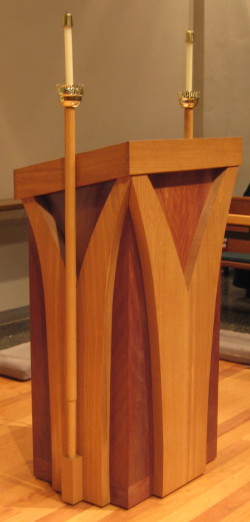 The lectern was designed by Reese Fowler to harmonize with his design for the altar. Masako Schwalbenitz, who also fabricated the altar, constructed the lectern using plans she developed from the design.
The lectern was designed by Reese Fowler to harmonize with his design for the altar. Masako Schwalbenitz, who also fabricated the altar, constructed the lectern using plans she developed from the design.
The desk is made from ‘ohi‘a veneer and white oak.
‘Ohi‘a veneer left over from the construction of the altar was used so that the two pieces would match as closely as possible.
All the white oak used in the lectern, including the veneer, came from one 12-inch-wide by 12-foot-long by 2½-inch-thick piece of lumber. The oak arms (branches) and surface of the desktop are veneered.
Stands for the torches (candles) are built into the lectern.
The lectern was paid for with funds given in memory of Don Alper.
Stained Glass Windows
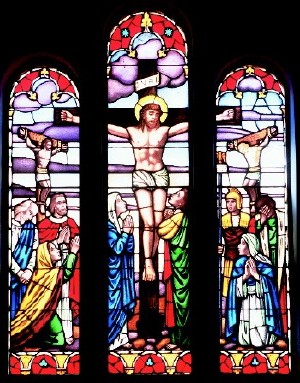 The triptych window depicting the Crucifixion is located above the reredos (wooden wall) separating the nave from the Boardroom. The window was designed by John Wallis of California and installed in the new Punahou church building in 1953.
The triptych window depicting the Crucifixion is located above the reredos (wooden wall) separating the nave from the Boardroom. The window was designed by John Wallis of California and installed in the new Punahou church building in 1953.
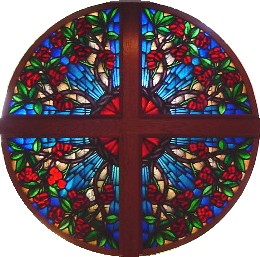 The rose window, also by John Wallis, was originally over the main door, facing Punahou Street, and was covered by the new von Beckerath organ, which was installed in the 1970s. It remained hidden until the time of the organ renovation, when it was reinstalled in front of the glass window by the baptismal font.
The rose window, also by John Wallis, was originally over the main door, facing Punahou Street, and was covered by the new von Beckerath organ, which was installed in the 1970s. It remained hidden until the time of the organ renovation, when it was reinstalled in front of the glass window by the baptismal font.
The design features a crown of thorns, using the “thorns flower,” a local flower. The rose window was incorporated into the elaborate form of the church logo, which is seen on the top of each page on this web site.
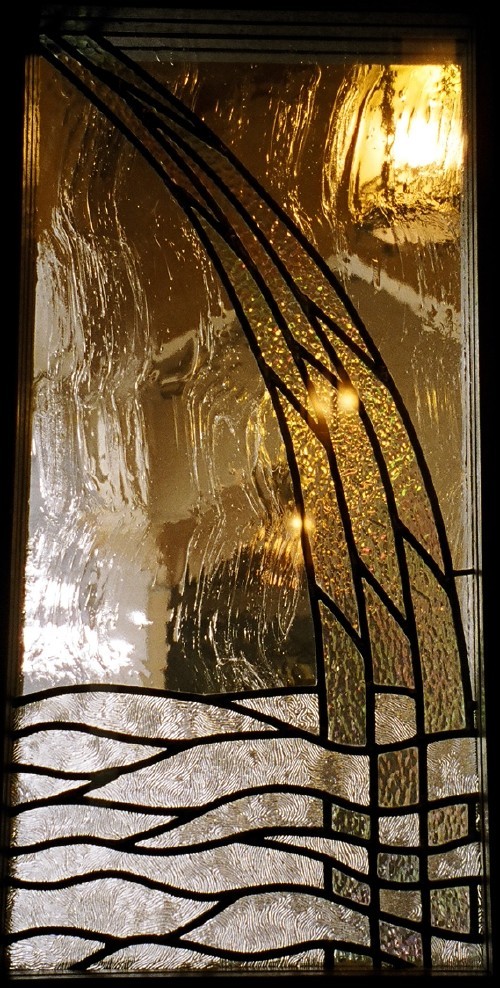 Windows were added in the Nave doors to create a more welcoming feeling for newcomers. The window panels were designed and fabricated by Randy Castello and given by the Castello family in honor of Randy’s parents, John (deceased Sept. 10, 2005) and Rosemary Castello. The design echoes the curved elements of the new altar and represents fountains of water pouring out of the heavens to be mingled with the waters of the earth. (Click on the detail on the right to view a larger version of the picture.)
Windows were added in the Nave doors to create a more welcoming feeling for newcomers. The window panels were designed and fabricated by Randy Castello and given by the Castello family in honor of Randy’s parents, John (deceased Sept. 10, 2005) and Rosemary Castello. The design echoes the curved elements of the new altar and represents fountains of water pouring out of the heavens to be mingled with the waters of the earth. (Click on the detail on the right to view a larger version of the picture.)
Clear glass was chosen for the panels so as not to compete with the colored windows inside the Nave, as well as to give those in the courtyard a glimpse of activity inside. The iridescent finish on the hammered glass used for the fountains makes them stand out. The background is made from a glass called Oceania, and the waves from Van Gough, a glass with ripples that reflect light like the ripples of the sea. The windows are leaded, rather than foiled.
Taizé Cross
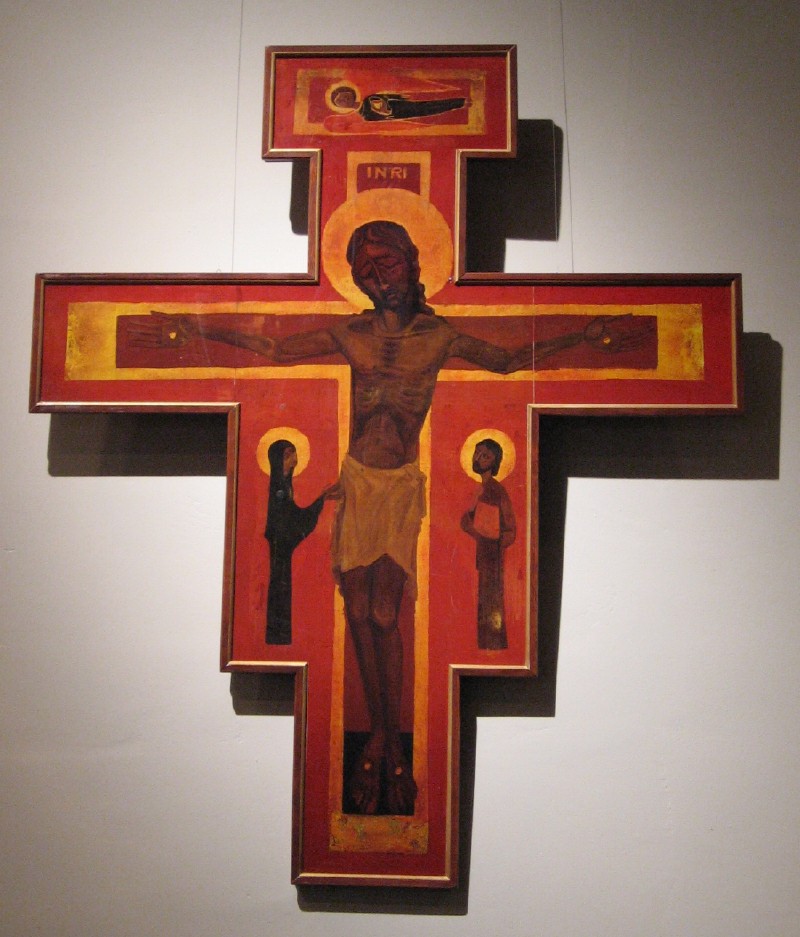 The Taizé Cross, which hangs on the back wall of the nave near the Boardroom, was made from a poster of the icon of the crucified Jesus, painted by Brother Eric of Taizé, that is in the Church of Reconciliation in the Taizé Community of France. The poster was ordered from the Taizé Community and mounted on a wooden frame by Randy Castello for Holy Week 1997.
The Taizé Cross, which hangs on the back wall of the nave near the Boardroom, was made from a poster of the icon of the crucified Jesus, painted by Brother Eric of Taizé, that is in the Church of Reconciliation in the Taizé Community of France. The poster was ordered from the Taizé Community and mounted on a wooden frame by Randy Castello for Holy Week 1997.
The Taizé Cross is taken down from the wall and used in the ritual of the Adoration of the Crucified on Good Friday.
(Click on the picture to the left to view a larger version.)
Eagle Lectern
 The eagle lectern was among the original furnishings of the Beretania Street church. Carved by noted Hawai‘i woodcarver Frank N. Otremba, it is a true copy of the lectern at Wartburg Castle in Germany, where Martin Luther translated the New Testament into German.
The eagle lectern was among the original furnishings of the Beretania Street church. Carved by noted Hawai‘i woodcarver Frank N. Otremba, it is a true copy of the lectern at Wartburg Castle in Germany, where Martin Luther translated the New Testament into German.
Along with the carved altar and pulpit from the Beretania Street church, the lectern was taken to the Punahou Street church in 1953. However, they were not incorporated into the 1973 renovation of the nave and fell into disuse.
Later, Astrid Hörmann, daughter-in-law of former Pastor Arthur Hörmann, had the finish stripped from the lectern and then refinished it herself. Because their apartment was small, every day she went out to the grove of ironwood trees at the Diamond Head end of Kapi‘olani Park to work on this project.
The eagle lectern was used by the officiant at Sunday evening Compline from its beginning in 1976 until the late 1990s, when it was involved in an unfortunate incident. Late one evening, an intruder was spotted in the Nave and the police were called to investigate. They found the person hiding among the men’s choir robes. A scuffle ensued, the lectern was overturned, and a large piece of one wing was broken off. The broken piece then disappeared.
As part of the preparations for the 100 year anniversary in 2000, the Church Council engaged a woodcarver to replace the missing wing and restore the lectern. It was taken to his workshop, but nothing was heard from him for over a year. In the meantime, Pastor Johnson retired, and when he moved out of his office, the missing wing emerged from behind some books. The woodcarver had not started the restoration work, and he was delighted to reattach the missing piece rather than fabricate a new one.
The eagle lectern has returned to its accustomed place at Compline, maintaining a link to the earliest days of LCH.
(Click on either of the details below to view a larger version of the picture.)

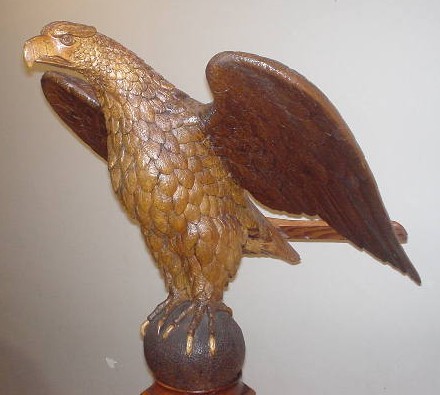
Kneeler Cushion

The kneeler cushion by Roy Helms repeats the carved design from the “Baby Beckerath” organ. The design uses only three stitches: Basketweave for the light background, Jacquard (a stitch very much like Byzantine) for the sun’s rays, and diagonal mosaic for the sides and back of the cushion. A gecko, overstitched in green on the back side of the cushion, is visible only to the individual giving the blessing or to curious children.
The original cushion for the kneeler was about six inches shorter and narrower than the new cushion. However, when Kathy Crosier printed out a pattern from a digital photo of the small organ, she thought she had been given the top surface dimensions instead of the dimensions for the whole covering (the top + both ends). It wasn’t until the needlepoint was done that everyone realized that they had created a much larger cushion, so they had to purchase a new backing board. As a result, it is now possible for three people to kneel at once rather than the more customary two.
Roy and Kathy are members of the In Stitches group which has made all of the pew cushions in the Nave
Comments welcome at webmaster@lchwelcome.org